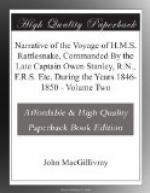When the rains set in the biyu becomes the principal support of the Cape York and Muralug people. This is a grey slimy paste procured from a species of mangrove (Candelia ?) the sprouts of which, three or four inches long, are first made to undergo a process of baking and steaming—a large heap being laid upon heated stones, and covered over with bark, wet leaves, and sand—after which they are beaten between two stones, and the pulp is scraped out fit for use. It does not seem to be a favourite food, and is probably eaten from sheer necessity. Mixed up with the biyu to render it more palatable they sometimes add large quantities of a leguminous seed, the size of a chestnut, which has previously been soaked for a night in water, and the husk removed, or the tuber of a wild yam (Dioscorea bulbifera) cut into small pieces, and well steeped in water to remove its bitter taste.
Among the edible fruits of Cape York I may mention the leara, a species of Anacardium or cashew nut (the lurgala of Port Essington) which, after being well roasted to destroy its acridity has somewhat the taste of a filbert—the elari (a species of Wallrothia) the size of an apricot, soft and mealy, with a nearly insipid but slightly mawkish taste—wobar, the small, red, mealy fruit of Mimusops kaukii—and the apiga (a species of Eugenia) a red, apple-like fruit, the pericarp of which has a pleasantly acid taste. The fruit of two species of pandanus yields a sweet mucilage when sucked, and imparts it to water in which it has been soaked, after which it is broken up between two stones, and the kernels are extracted and eaten.
No recognised chieftainship.
Throughout Australia and Torres Strait, the existence of chieftainship, either hereditary or acquired, has in no instance of which I am aware been clearly proved: yet in each community there are certain individuals who exercise an influence over the others which Europeans are apt to mistake for real authority. These so-called chiefs, are generally elderly men, who from prowess in war, force of character, or acknowledged sagacity, are allowed to take the lead in everything relating to the tribe. In Torres Strait such people are generally the owners of large canoes, and several wives; and in the northern islands, of groves of coconut-trees, yam grounds, and other wealth. Among the Kowraregas, there are, according to Giaom, three principal people, Manu, Piaquai, and Baki, all old men, but among the Gudangs, a young man of twenty-five of the name of Tumagugo appeared to have the greatest influence, and next to him Paida, not more than six or eight years older.
Laws regarding property in land.




